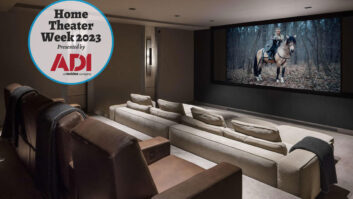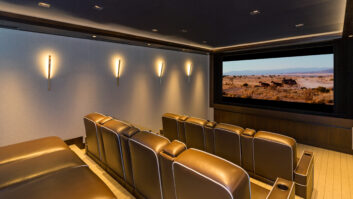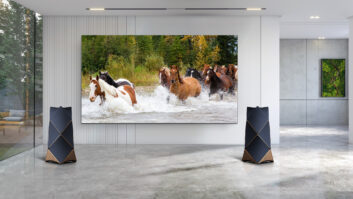by John Sciacca
Outside of control companies like Crestron, Control4 and even Lutron where dealers are required to attend training to be certified before they can sell and install systems, not many companies even offer any formal factory training. And this is especially true in the video segment, where generally a pulse and hot PO is all that is required to sell the latest flat panel set.
One company that stands apart from this is Runco. They have been conducting factory training for years; training dealers around the world in the best ways to sell, install and optimize their projectors and displays. I recently attended a training class at Runco’s factory headquarter in Beaverton, OR, and will share my experience.

John Sciacca outside Runco’s factory headquarter in Beaverton, OR. For a slideshow of photos from Sciacca’s visit, click here.
First, to encourage dealers to attend, the class is offered at no charge; attendees are responsible only for their travel and hotel charges. The class is called “Runco Academy” with the slogan, “Mastering the Art of Home Cinema.” Academy has a fairly rigorous pace spread over four days, starting at 8:00 each morning – except for a merciful 9:30 start on Sunday – and running until at least 5:00 each day.
As an added bonus, there are two group dinners where Runco picks up the tab. Adam Pelz from Bespoke Cinemas out of Atlanta, GA, commented, “The largest wealth of knowledge at these events is the experiences learned from other dealers.” And to that end, these informal events give attendees a chance to get to know one another and swap shop-talk.
Day one began with a history of Runco – which was founded in 1986 – and Planar – which acquired Runco in 2007. Sales training was the first day’s main focus, where the importance of having a passion about the products that you sell was stressed. High-end components, like Runco products, should be positioned as luxury items and dealers that sell them as luxury suppliers.
Also stressed was the benefit of personalization and customization. Amongst luxury purchasers, many aren’t looking for a “me too” experience; they want something that will be seen as unique to them. And the terms “customization” and “personalization” are now firmly ensconced in the luxury lexicon. And just as the leather interior on a Bentley can be ordered in any color, Runco is unique in offering a product line that can be customized to fit each homeowner’s needs and wants.
The point was made that dealers should stop thinking of luxury as a noun, but more of a verb; turning, “We sell home theater equipment” into, “We provide the best cinematic experiences in your home!”
Jim Anthony, president, Simply Automation located in Eau Claire, WI, brought up the valuable mental difference between having clients versus customers. “It is a total mind shift to how you recommend things. With a client, you’re now on the same team, like an attorney relationship. You are now on their team, looking out for their interests.”
Dealers were encouraged to communicate with prospective customers, err, clients primarily through questions. The key to questioning, we were told, lies in your ability to differentiate yourself from your competition. And by asking smart questions, customers will think you are smart. (Conversely, ask dumb questions, and…) Runco claims that more sales are lost through poor questions and poor salesmanship rather than to lowest price, and that the person who asks the questions has the control. Ultimately, clients buy the salesperson first, not products.
A short van ride led us to the facilities where all Runco components are assembled, tested, repaired, and shipped out. Techs could be seen bench-testing items returned from dealers or calibrating new units about to be sent out. The shipping facility had a large crane arm used for hoisting the mammoth 103-inch plasma sets onto trucks, one of which was boxed up and ready to go.

A large hoist is used to transport 103-inch Plasma sets onto trucks for delivery.
Sales training concluded with a walk-through the Runco product line, which features the largest home cinema product portfolio in the market. Runco stressed that models are available to address any installation need or requirement with projectors starting at under $5,000 and running to more than $250,000, including Digital Cinema Concierge (DCC) systems.)
Our sales training concluded with “The Art of the Demo,” where Runco described and demonstrated best practices for preparing potential clients for demonstration and tips for ensuring a “Wow!” experience every time and how to replicate the famous “pitch black” Q-demo from CEDIA.
The remainder of the Academy focused on technical training, where attendees were taught how the human eye works and how we see, and how that translates to producing good – or bad – video images. They covered a history of film and commercial cinema technologies and aspect ratios, with a good segue into how Runco eliminates black bars to produce a more cinematic experience with their CineWide process.
With its current market awareness, a good portion of time was spent discussing 3D, including its development, history in the commercial space up, its rise-fall-rise in popularity, and a comparison of the competing, modern digital 3D formats such as IMAX 3D, RealD, Dolby 3D, and XpanD.
Home technologies such as DLP — single- and three-chip — LCD, LCoS, and plasma were explained and compared as well as the importance of proper positioning and installing a projector to account for throw distance, lens offset, and thermal management.
Other installation factors were explained, such as choosing screen materials and screen gain and the affect on screen size has on light output (ie: doubling the screen size diagonally results in one-quarter the brightness!). Also discussed was optimizing the system for the viewing environment such as seating distance, room treatment colors, furniture. They discussed the trifecta of home theater install screw-ups: light (too much ambient light present or not enough projector horsepower); system resolution (either sitting too close, or having too large a screen); and source resolution (clients watching SD material).
Levi Angst, from Integration Excellence out of Lebanon, MO, commented, “As a new dealer, I found the Runco Academy experience beneficial. The class is effective in training a new dealer about product categories and technologies.”
The remainder of the technical training focused on the importance of properly setting up a display device for maximum performance and the benefits and methodology for calibrating a display. The training covered not only basic brightness and contrast adjustments for maximizing dynamic range but also accurately measuring and adjusting the grayscale and primary and secondary color points. A PowerPoint slide from company founder, Sam Runco, explained why displays should be calibrated. “Every Runco HDTV is engineered for ISF (Imaging Science Foundation) calibration. Understanding TV calibration is simple at our company – calibrating Runco HDTVs insures happy Runco HDTV owners. Period.”

Jeff Murray from SpectraCal explains projector calibration.
Guests from SpectraCal demonstrated their CalMan software suite for calibrations and discussed the different types of meters used for proper color and grayscale calibration as well as walking through the calibration process on several displays. In addition, a suite of calibration tools was offered at special pricing to class graduates. Part of the class curriculum included completing the 100-question ISF exam, leaving attendees prepared to should they wish to pursue receiving full ISF certification.
On the final day, there was an opportunity to try your hand at calibrating grayscale on a couple of projectors as well as installing two of Runco’s anamorphic lens offerings; the fixed “Whitney” on an LS-3 and the monstrous “McKinley” on a premium SC-50d. Of course, the company’s D-73d, dual-stack LED powered, passive 3D projector was on hand to wow attendees with some of the finest 3D video available. I wasn’t the only one impressed by the stunning 3D presentation as Pelz noted, “The most compelling display of technology was seeing 3D gaming done extremely well and on a very large screen [via the D-73d].”
The overall message was to arm students with the knowledge necessary to sell premium display technologies and ready graduates to go forth and “save the world from bad video!” If you are interested in scheduling a seat at Runco Academy, contact your Runco representative or the company directly at 800.23.RUNCO.







